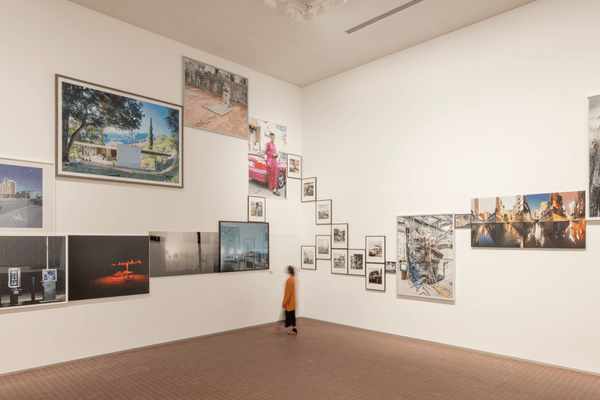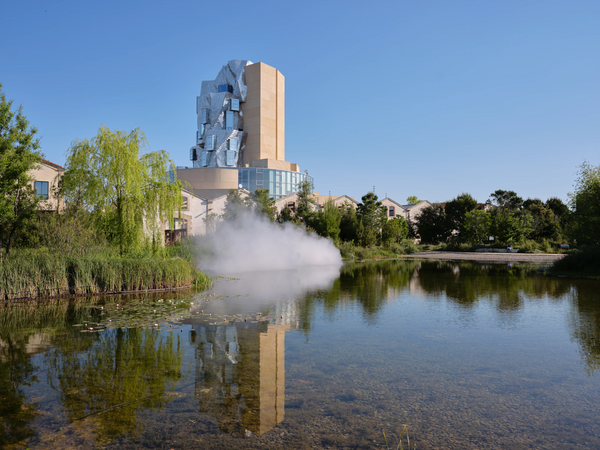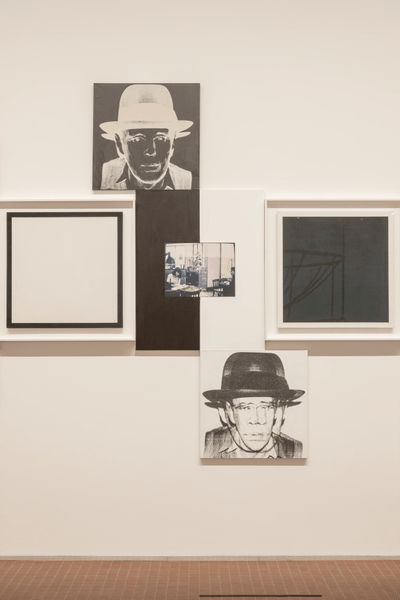Streaming from our eyes

Streaming from our eyes (past: Dancing with the Demons)
LUMA Arles
From May 01 to November 02, 2025
What does a curator—or a group of curators, for that matter—do when charged with the task of reinventing an exhibition in a different space? This is the premise of Dancing with the Demons (the title at the time of my visit), an evolving body of works coming from the Fondation Beyeler collection as well as loans from Maja Hoffmann / LUMA Foundation. Dancing with the Demons actually stands as one iteration in a lineage of shows that began much earlier, with Il Tempo del Postino in Manchester in 2007, curated by Philippe Parreno and Hans Ulrich Obrist. It was later reinvented as To the Moon via the Beach during the Rencontres d’Arles in 2012. Its latest incarnation took place at the Beyeler Foundation in 2024 (Summer is Over), before being reborn here at the Luma Foundation in Arles in 2025. This construct—of art, artists, curators, ideas, and places—resembles a transformational journey, an alchemical reaction turning one matter into another, one exhibition into another.
The space itself feels like a whirlpool: a spiral wave of works hung along the walls of Luma’s Main Gallery, enveloping an impressive, imposing central structure. Hung in a continuous flow, the works seem codified, following a rhythm—or perhaps an algorithm—we are invited to decipher. It might be a game of associations, or a rhizomatic evolution of themes, techniques, colors, and contrasts, resulting in an intuitive scenography that places each piece into an unexpected and, frankly, elemental context. Marlene Dumas and Wilhelm Sasnal’s portraits pour into Roni Horn’s a.k.a. series of self-portraits, which transform into Aura Rosenberg’s photographs of Greco-Roman statues from her series Statues Also Fall in Love, which in turn become images of architecture. And so on. The whole exercise feels Warburgian—playful, straightforward, and honest.

Especially so at the end, where two monochrome paintings by Ellsworth Kelly (White and Black squares) are paired in a cross-shaped arrangement with two of Andy Warhol’s monochrome portraits of Joseph Beuys—one double-exposed, the other in negative. The group connects through Ian Wallace’s yin-yang-inflected Masculin/Féminin (The Café Scene). It’s refreshing to witness, for sometimes a cigar is just a cigar. (1)
But before noticing all of this, I was fully drawn to the center. That is, to the circular metal structure suspended by massive chains which is, in fact, A Library as Large as the World—designed by philosopher Federico Campagna and designer Dozie Kanu. Built as a compass, its four cardinal points subliminally lead the reader through the symbolic cycles of seasons, age, and belief. We first observe books holding firm convictions about the world, then move to those that question those convictions, to writings that carry no belief at all. The final group is fiction, which restarts the process of constructing faith. The gravitational pull of the library captures the viewers inside its metal dome —expressly those imbued with intellectual curiosity. One can’t help but think of a panoptic structure, especially under the gaze of Ryan Gander’s Magnus Opus and the attentive ears of Pierre Huyghe’s Idioms.
In a way, the exhibition revolves around this opposition of matter—the visual and sensory aspects orbiting an intellectual nucleus. Separated, yet close.
Like an atom with its protons and electrons—or better yet, like Saturn and its rings—the codified spiral of images rotates around the central planet, fastened and interdependent in sacred balance. This continuous motion recalls the grand cycles of Baroque painting, in which spectators are enveloped in a concerto of motion. And it is no surprise, considering the exhibition was conceived under the curatorial impact of not only a performing artist but a choreographer. Tino Sehgal applies to the works what he typically does to bodies: inscribing them in a “constructed situation,” to use his own term. Working in layers, Sehgal builds strata not only before the exhibition opens, but throughout its duration. Over six months, the show will change titles 17 different times (at the time of my writing, it is called Streaming from Our Eyes)—and with that, the key to the reading of the works.

The flow of the exhibition doesn’t stop at the gallery walls. It spills out into Luma’s park, where three temporary installations inherited from the Beyeler iteration mingle with the site’s permanent inhabitants.
A mysterious greenhouse by Precious Okoyomon pulls visitors in with a recurring scream. Inside, a teddy bear-like creature sleeps among what we learn to be poisonous plants and fluttering butterflies. Scary and adorable, she seems trapped in a somber dream, echoing another work inside the tower: Carsten Höller and Adam Haar’s Dream Hotel Room, which invites viewers to partake in actual sleeping and dreaming sessions.
Further on, Fujiko Nakaya’s fog sculpture takes over part of the lake, expanding and contracting, physically touching us with its cold mist. The piece echoes another exhibition at Luma this season—Sensing the Future—in which we learn about its origins at the Pepsi Pavilion of the 1970 Osaka World Expo. This work is so simple—replicating a natural phenomenon—and yet it is in this simplicity that we feel alive, present, in the here and now. If Turner invented the sunset, Fujiko invents the fog.
Finally, Philippe Parreno’s Membrane tower mirrors the Luma Tower itself. This giant mechanical octopus transports viewers into a sci-fi landscape, responding cybernetically to its environment—sound, humidity, even presence—through 52 sensors. We question whether this robotic sculpture might actually sense more than we humans do. A successful exhibition, in my opinion, is one that leaves viewers both understanding and feeling understood. This balance is conveyed through a web of connections and associations—between works, between past and present iterations, between concurrent exhibitions at Luma. Dancing with the Demons situates itself within that web, inviting discovery and rediscovery alike.

(1) “One of Freud’s most famously mis-quoted sayings is ‘Sometimes a cigar is just a cigar’. The phrase is constantly attributed to Freud, but there is no evidence that Freud ever said or wrote it.” https://www.freud.org.uk/2020/04/22/freud-and-his-cigars/
Head image : « Danse avec les démons », 2025, Parc des Ateliers, LUMA Arles, France. Federico Campagna et Dozie Kanu, Une bibliothèque aussi grande que le monde, 2025. Matériaux mixtes. Pierre Huyghe, Idiom, 2023. Voix générée en temps réel par l’intelligence artificielle, masques LED dorés. © Victor&Simon – Grégoire D’Ablon
- Share: ,
- By the same author: Déborah Bron & Camille Sevez, Sanam Khatibi, Ho Tzu Nyen, GESTE Paris, The summer of collaboration at CRAC Alsace and CRÉDAC: “L’amitié : ce tremble” and "Tripple Dribble",
Related articles
Performa Biennial, NYC
by Caroline Ferreira
Camille Llobet
by Guillaume Lasserre
Thomias Radin
by Caroline Ferreira